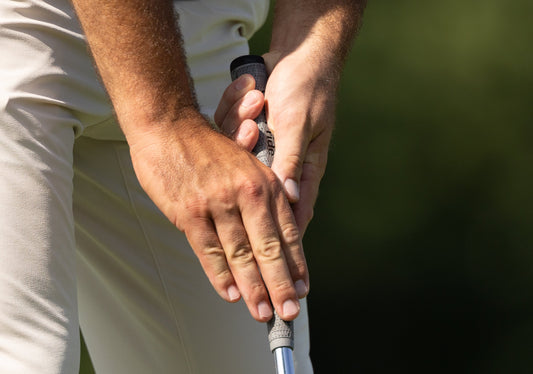Image Credit: Jun 19, 2025; Cromwell, Connecticut, USA; The putting grip of Scottie Scheffler on the 12th hole during the first round of the Travelers Championship golf tournament. Mandatory Credit: Bill Streicher-Imagn Images
Three-foot putts shouldn't keep you awake at night. Yet here you are, standing over another knee-knocker, hands trembling as doubt creeps through your mind like poison.
I've watched hundreds of golfers torture themselves on the greens.
Decent ball-strikers who could thread a 7-iron through a keyhole suddenly turn into quivering messes when faced with a short putt to save par. The conventional grip that serves them well from tee to green becomes their enemy on the putting surface.
That enemy has a cure. It looks weird, feels awkward at first, and violates everything you've been taught about gripping a golf club. But it works.
What Is the Claw Putting Grip?
Think of how you hold a pencil when writing your name. Now apply that same principle to your putter. Sounds crazy? Tell that to Scottie Scheffler, who rode this technique to a Masters victory and the number one ranking in the world.
The claw transforms your dominant hand from a power source into a guide. Instead of wrapping all five fingers around the grip in traditional fashion, you create a "claw" formation. Your thumb and index finger pinch the grip while the remaining three fingers provide light support from below.
Chris DiMarco pioneered this method during his heyday on tour, but today's stars have perfected it. Justin Rose used it to claim a U.S. Open. Webb Simpson putted his way to victory at the Players Championship. Tommy Fleetwood deployed it during his rise up the world rankings.
These men don't experiment with putting grips for fun. They adopt techniques that work under the crushing pressure of professional golf, where a single missed putt can cost millions of dollars.
Executing the Claw Grip

Your non-dominant hand stays put. Left-handed golfers keep their right hand conventional, right-handers maintain their left hand placement. This becomes your anchor—stable, reliable, unchanging throughout the stroke.
Everything interesting happens with your dominant hand.
Place your thumb on the front-right section of the grip, exactly where it normally goes. Nothing revolutionary there. But now comes the weird part: that index finger you've always curled around the grip needs to straighten out and point down the shaft toward the ball, like you're giving directions to your target.
Your other three fingers barely make contact. They hover beneath the grip, offering subtle support without applying pressure. Don't squeeze. Don't grip. Just let them rest there, ready to assist but never interfere.
This hand now guides rather than controls. Think of the difference between gently steering a bicycle and wrestling with a stubborn steering wheel—same destination, completely different approach.
Why This Method Destroys Traditional Putting Problems
Most golfers battle their dominant hand every time they putt. That hand wants to take charge, twisting the clubface, adding unwanted wrist action, creating the very inconsistency that drives you crazy.
The claw removes your dominant hand from the equation.
With reduced influence from your stronger hand, your shoulders and non-dominant hand power the stroke. This creates the pendulum motion that every putting instructor preaches, but few golfers actually achieve. Smooth. Consistent. Repeatable.
Your wrists stop being troublemakers. No more flipping at impact. No more last-second face manipulations that send putts careening off your intended line. Just mechanical precision that breeds confidence.
The Benefits Hit Fast and Hard
Distance control improves first. Without your dominant hand overpowering the stroke, you develop a genuine feel for different lengths.
Those lag putts that used to rocket past the hole start dying near the cup like well-behaved pets.
Accuracy follows immediately behind. A square putter face at impact means putts start on your chosen line consistently. Breaking putts that used to confuse you become manageable puzzles with clear solutions.
But confidence? That's where the magic lives.
Short putts lose their sting. Three-footers that once made your hands shake become routine exercises. Four-footers that kept you tossing in bed the night before big rounds turn into simple tasks. The grip's inherent stability convinces your brain that making putts is normal, expected, inevitable.
I've seen golfers transform overnight. One day, they're fighting their dominant hand through every stroke, shoulders tense with anticipation of failure. The next day, they're standing over putts with calm assurance, knowing the ball will go where they aim it.
Making Your Transition Work
Don't rush this. Every meaningful change in golf demands patience.
Start without a ball—just you, your putter, and the new grip. Make slow strokes, feeling how different everything becomes when your dominant hand steps back from its controlling role. The motion feels foreign initially because it IS foreign. That's normal.
Move to short putts on the practice green. Three feet maximum at first. Concentrate on solid contact and steady rhythm rather than making every putt. Trust develops gradually, not instantly.
Some golfers adapt in days. Others need weeks or months to fully integrate the change. Your timeline depends on practice frequency and your comfort with abandoning familiar patterns. Don't force quick results—they'll backfire
The Bottom Line
This grip won't win beauty contests. It challenges conventional wisdom about how golfers should hold their clubs.
But major champions trust it under the most intense pressure in golf. Struggling amateurs rediscover their putting confidence through it. When something transforms your most frustrating golf skill into your greatest strength, appearance becomes irrelevant.
Your putting demons aren't permanent residents. Sometimes the solution isn't trying harder with failed methods—it's having the courage to try something that looks completely different.
Give the claw grip a legitimate chance. Your scores will improve. Your confidence will soar. And those three-foot putts? They'll finally start behaving.





